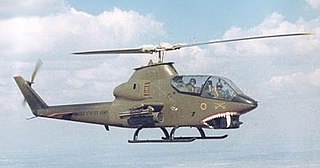
The Bell AH-1 Cobra is a single-engined attack helicopter developed and manufactured by the American rotorcraft manufacturer Bell Helicopter. A member of the prolific Huey family, the AH-1 is also referred to as the HueyCobra or Snake.

The Boeing AH-64 Apache is an American twin-turboshaft attack helicopter with a tailwheel-type landing gear and a tandem cockpit for a crew of two. Nose-mounted sensors help acquire targets and provide night vision. It carries a 30 mm (1.18 in) M230 chain gun under its forward fuselage and four hardpoints on stub-wing pylons for armament and stores, typically AGM-114 Hellfire missiles and Hydra 70 rocket pods. Redundant systems help it survive combat damage.

The Bell AH-1 SuperCobra is a twin-engined attack helicopter that was developed on behalf of, and primarily operated by, the United States Marine Corps (USMC). The twin Cobra family, itself part of the larger Huey family, includes the AH-1J SeaCobra, the AH-1T Improved SeaCobra, and the AH-1W SuperCobra.

Marine Light Attack Helicopter Squadron 367 (HMLA-367) is a United States Marine Corps helicopter squadron consisting of AH-1Z Viper attack helicopters and UH-1Y Venom utility helicopters. Originally commissioned during World War II, the squadron participated in combat operations on Peleliu and Okinawa. Reactivated during the Vietnam War, the squadron has served during numerous conflicts since. The squadron is based at Marine Corps Air Station Camp Pendleton, California and falls under the command of Marine Aircraft Group 39 (MAG-39) and the 3rd Marine Aircraft Wing.
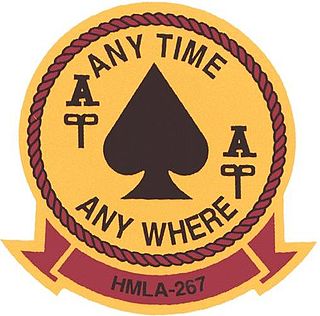
Marine Light Attack Helicopter Squadron 267 (HMLA-267) is a United States Marine Corps helicopter squadron consisting of Bell AH-1Z Viper attack helicopters and Bell UH-1Y Venom utility helicopters. Nicknamed the "Stingers", the squadron is based at Marine Corps Air Station Camp Pendleton, California and falls under the command of Marine Aircraft Group 39 (MAG-39) and the 3rd Marine Aircraft Wing.

Marine Light Attack Helicopter Squadron 775 (HMLA-775) is a reserve United States Marine Corps helicopter squadron consisting of Bell AH-1Z Viper attack helicopters and Bell UH-1Y Venom utility helicopters. The squadron was reactivated from cadre status on 1 Oct 2016 and is based at Marine Corps Base Camp Pendleton, California and falls under the command of Marine Aircraft Group 41 (MAG-41) and the 4th Marine Aircraft Wing.

Marine Aircraft Group 39 (MAG-39) is a United States Marine Corps aviation unit based at Marine Corps Base Camp Pendleton, California that is currently composed of four AH-1Z "Viper" Cobra and UH-1Y "Venom" Huey light attack squadrons, two MV-22 Osprey squadrons, an aviation logistics squadron, a Headquarters Squadron, a Marine Wing Support Squadron and the H-1 Fleet Replacement Squadron. The group falls under the command of the 3rd Marine Aircraft Wing and the 1st Marine Expeditionary Force
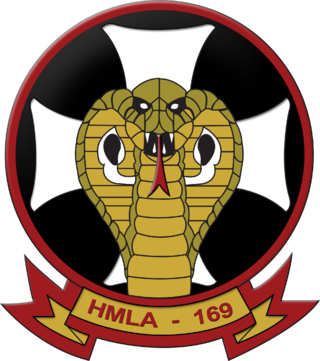
Marine Light Attack Helicopter Squadron 169 (HMLA-169) is a United States Marine Corps helicopter squadron consisting of AH-1Z Viper attack helicopters and UH-1Y Venom utility helicopters. The squadron is based at Marine Corps Air Station Camp Pendleton, California and falls under the command of Marine Aircraft Group 39 (MAG-39) and the 3rd Marine Aircraft Wing.

Marine Light Attack Helicopter Squadron 269 (HMLA-269) was a United States Marine Corps helicopter squadron consisting of AH-1Z Viper attack helicopters and UH-1Y Venom utility helicopters. Also known as "The Gunrunners", the squadron was based at Marine Corps Air Station New River, North Carolina and fell under the command of Marine Aircraft Group 29 (MAG-29) and the 2nd Marine Aircraft Wing.

Marine Light Attack Helicopter Training Squadron 303 (HMLAT-303), is a United States Marine Corps helicopter training squadron stationed at Marine Corps Air Station Camp Pendleton, California. Known as "Atlas", HMLAT-303 trains newly commissioned Naval Aviators, conversion pilots, and refresher pilots to fly the Bell UH-1Y Venom and Bell AH-1Z Viper. HMLAT-303 is also responsible for training Bell UH-1Y Venom crew chiefs. It is part of Marine Aircraft Group 39 (MAG-39) and the 3rd Marine Aircraft Wing.

The AGR-20 Advanced Precision Kill Weapon System (APKWS) is a design conversion of Hydra 70 unguided rockets with a laser guidance kit to turn them into precision-guided munitions (PGMs). APKWS is approximately one-third the cost and one-third the weight of the current inventory of laser-guided weapons, has a lower yield more suitable for avoiding collateral damage, and takes one quarter of the time for ordnance personnel to load and unload.
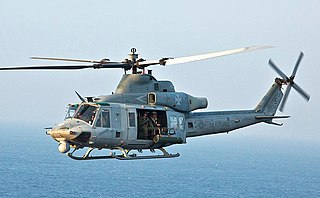
The Bell UH-1Y Venom is a twin-engine, 4-blade, medium-sized utility helicopter built by Bell Helicopter under the H-1 upgrade program of the United States Marine Corps. One of the latest members of the numerous Huey family, the UH-1Y is also called "Yankee" for the NATO phonetic alphabet pronunciation of its variant letter. Bell was originally to produce UH-1Ys by rebuilding UH-1Ns, but ultimately used new built airframes. In 2008, the UH-1Y entered service with the Marine Corps and also began full-rate production. The new UH-1 variant replaced the USMC's UH-1N Twin Huey light utility helicopters, introduced in the early 1970s. The helicopter were ordered by the Czech Republic and the helicopter is in production in the early 2020s.

Marine Corps Air Station Camp Pendleton or MCAS Camp Pendleton is a United States Marine Corps airfield located within Marine Corps Base Camp Pendleton, California. It was commissioned in 1942 and is currently home to Marine Aircraft Group 39. The airfield is also known as Munn Field in honor of Lieutenant General John C. "Toby" Munn, the first Marine aviator to serve as the Commanding General of Marine Corps Base Camp Pendleton.

The Bell UH-1N Twin Huey is a medium military helicopter designed and produced by the American aerospace manufacturer Bell Helicopter. It is a member of the extensive Huey family, the initial version was the CUH-1N Twin Huey, which was first ordered by the Canadian Forces in 1968.
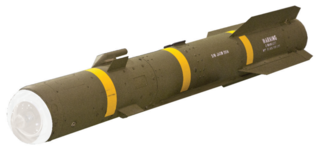
The AGM-179 Joint Air-to-Ground Missile (JAGM) is an American military program to develop an air-to-surface missile to replace the current air-launched BGM-71 TOW, AGM-114 Hellfire, and AGM-65 Maverick missiles. The U.S. Army, Navy, and Marine Corps plan to buy thousands of JAGMs.

The Bell Huey family of helicopters includes a wide range of civil and military aircraft produced since 1956 by Bell Helicopter. This H-1 family of aircraft includes the utility UH-1 Iroquois and the derivative AH-1 Cobra attack helicopter series and ranges from the XH-40 prototype, first flown in October 1956 to the 21st-century UH-1Y Venom and AH-1Z Viper. Although not flown in military service in the USA, the Bell 412 served in Canada and Japan, and like the UH-1Y is a twin engine four rotor design based on the Bell 212.
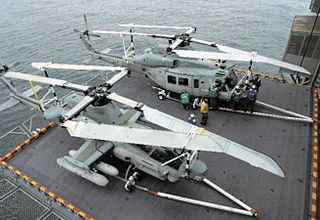
The H-1 upgrade program is the United States Marine Corps's program to develop the AH-1Z Viper and UH-1Y Venom military helicopters to replace its aging fleets of AH-1W SuperCobras and UH-1N Twin Hueys. The contract was awarded in 1996 to Bell Helicopter, the original manufacturer of both aircraft, to design the new airframes as modernized attack and utility helicopters with considerable design commonality, to reduce operating costs.
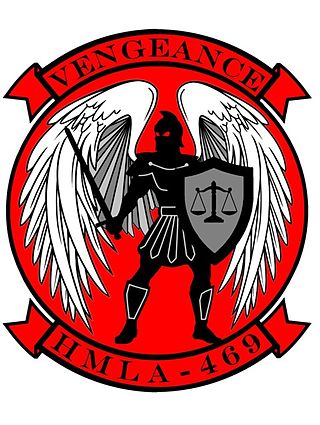
Marine Light Attack Helicopter Squadron 469 (HMLA-469) was a United States Marine Corps helicopter squadron consisting of AH-1 SuperCobra and AH-1Z Viper attack helicopters and UH-1Y Venom utility helicopters. The squadron was last headquartered at Marine Corps Air Station Camp Pendleton in Southern California and fell under the command of Marine Aircraft Group 39 (MAG-39) and the 3rd Marine Aircraft Wing. The squadron was commissioned on 30 June 2009 and decommissioned on 16 December 2022.
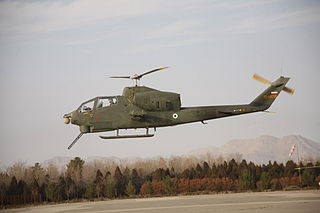
The IAIO Toufan or Toophan is series of combat helicopters by the Iran Aviation Industries Organization. Based on the US-built AH-1J SeaCobra, the Toufan has two variants, the Toufan I unveiled in May 2010 and the improved Toufan II unveiled in January 2013.

Marine Rotational Force – Darwin is a marine air-ground task force of the United States Marine Corps based at Robertson Barracks and at RAAF Base Darwin, near the city of Darwin in the Northern Territory of Australia.




























